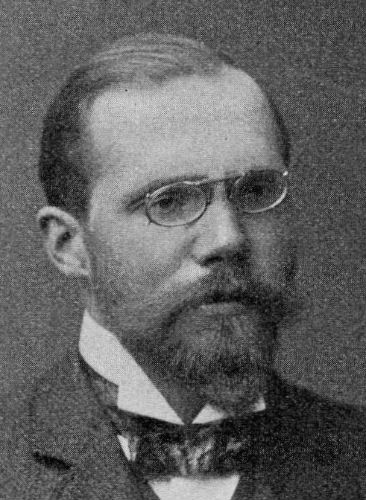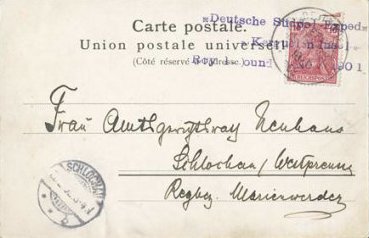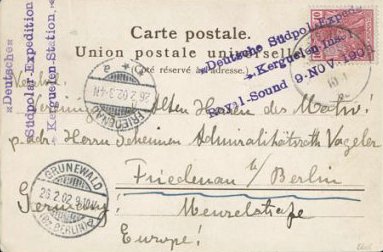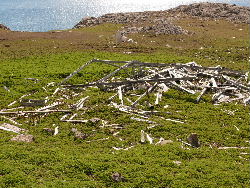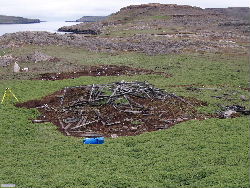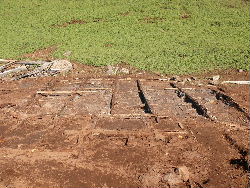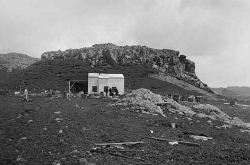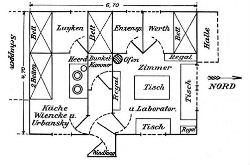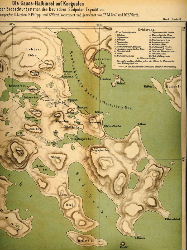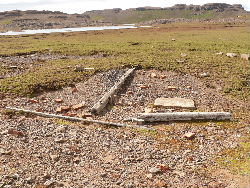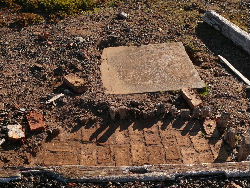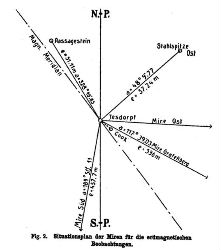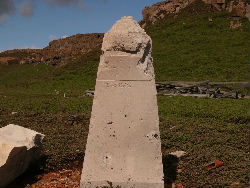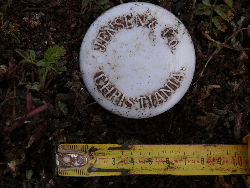•  Reports 14th German Geographer's Meeting in Berlin (1903) (9 MB) (German) Reports 14th German Geographer's Meeting in Berlin (1903) (9 MB) (German)
Karl's report on the Kerguelen expedition on page 86
1.
On the Kerguelen Station of the German South Pole Expedition.
By Station Member Dr. K. Luyken.
(1st Session)
When in the years 1900 and 1901 the far-sighted preparations for the German South Pole Expedition were being performed
the equipment of an obeservation station was also approached. The station was meant as a launching point as well as a
base for the meteorological and terrestrial magnetical measurments on board the South Pole ship as well as later on the
Antractical Region itself.
|
The location of this base station was meant to be on the
Kerguelen Islands which once seemed well suited because
of their southern location as well as their proximity to the operation line of the main expedition and because
of their mostly unexplored interior which promised a rich bounty in every way for research science.
The German South Pole ship "Gauss"
left home on August 11th 1901.
From the members of the Kerguelen expedition only the biologist Mr. Dr. Werth and the sailor Urbanski were
on board while Mr. Enzensperger and me sailed
a few days later together with the second sailor Wiencke towards Sydney with a ship of Norddeutsche Lloyd in order to
continue the voyage from there to the Kerguelen Islands with the steamer "Tanglin" which also belongs to Lloyd.
On the same ship sailed the dispatch of supplies and the construction timber for the Kerguelen station as well as
for the main expedition.
|

The Kerguelens
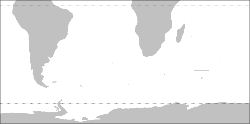
Location of the Kerguelens
|
After a six day sojourn in Sydney, which suited the purpose of the transshipping of these materials as well as
of the taking over of the polar dogs which were sent here from East Siberia, we left harbour and therefore the last
civilization site on October 12th in order to sail due southwest
towards the Kerguelens.
The voyage proceeded in a throughout heavily gusty weather and was particularly slowed down because in the
region of the so-called brave west-winds we had to sail against the constant wind direction and the strong swells.
The sea went very high on individual days so that in two occasions we even were forced to turn about by the
12 m towering waves.
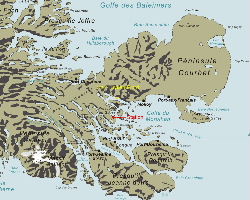
Station's location
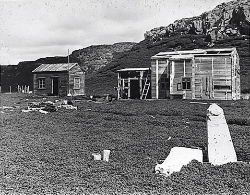
Relics of the old house of the
German South Pole Expedition.
On the left side a later hut, probably from
Baron Decouz und Valerian Culet.
They tried to raise sheep.
|
After a journey of four weeks, with an average speed of 5.7 knots per hour, on the morning of
November 9th we were located before the outlet of Royal Sounds of the
Kerguelens, which deeply intrudes into the island from South-East, then divides into a series of westerly
fjord-like incisions and harbours countless smaller and bigger islands in its huge basin.
After we entered the so-called Three Island Harbour, which is formed by three islands, well sheltered from North
by a fourth one from storms, we were convinced by a short visit of the westerly "Hog Islands" that the primordial
plan of settling a station there was not feasible. After depositing a message in a bottle we threfore
lifted anchor and sailed on due West towards Observatory Bay which opened before us after an approximately
one-hour trip. After searching and circling the fjord for two days we opted for the site on the southern side of the bay,
close to the 15 m-high shore, where during the year 1874 the English Volage Expedition had made observations
over a time of three months on behalf of the passage of Venus. We encountered here, close to the eastern slope of one
of the many basaltic mounds that cover the shoreline around, also the wind-crooked ruins of the old house whose
woods and boards were a welcome supplementary material for our building purposes.
|
The construction of the new station house was started on the same spot, which was very well sheltered against
the usual west and northwest wins.
During the time from November 9th until
December 21st the "Tanglin" remained in the bay. First the timber and the
supplies of the Keguelen station had to be brought on land, after which the dwelling house and, not very far
away from it, the house for the magnetic variations was built.
|
Because the South Pole ship "Gauss" we were expecting had not yet arrived, the timber and supplies as well as the coal
assigned to it had also to be brought on land. As the Chinese crew was wholly flabby and unfit because of the effect
of climate and supported our work only in a minimal way, the unloading could only be carried out by landing the
"Tanglin" for a period of 10 days at a not unperilious spot quite near a ledge, the captain of the ship,
Mr. Neuhauss, operating in a very cautious and canny way in order to be safe should a storm break in
from the North or East. After these fortunately overcome ten days the ship went back to anchor at the former
spot were it remained.
|
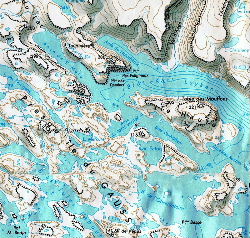
Location of Observatory Bay
and the Karl-Luyken-Fjord
|
During this time two of the Chinese stokers succumbed to beriberi
which already had broken out among the crew during the journey and which became so bad that as the "Tanglin" left,
only two stokers from eleven were fit for service so that the captain was forcerd to commit the three Siberians
who had transported the polar dogs to shovel coal.
After, as said, the "Tanglin" left on December 21st the setting work was
continued by all three of us, Mr. Enzensperger, me and the sailor, until at last after a ten-day waiting the
dark masts of the "Gauss" appeared on Observatory Bay. The greeting after an almost five-month separation was
even joyfuller as we found all fellows on board "Gauss" in best health.
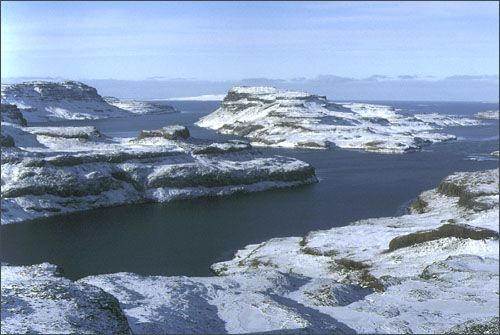
Karl-Luyken-Fjord on the left side
|
With moving paticipation of the crew a large part of the furnishings as well as the setup of the observatory
for measuring the absolute magnetism were carried out, while the "Gauss" took over its assigned cargo on board by
boats. After a month of collective strenuous activity, but which awarded us some merry hours of being togehter on
the evenings, everthing was ready for departure and on January 31st the
"Gauss" hoisted anchor after we most warmly had bid farewall to all fellows who confronted the many strains and perils
of the ice region. -
|
The so-called international observation year was set to begin on February 1st.
Therefore our regular meteorological and earth-magnetical measurements also began at this time. The meteorological
service which was overseen by Mr. Enzensperger corresponded to a station of first order, so it ranged over the
observation of dates and the continuous recording of the elements of air pressure, temperature, humidity as well as
of wind direction and speed. The ground temperature was controlled by daily readings up to a depth of 2 m
in a spot which was found only after a long search. Later, constant photometric and air-electrical measurements were
added. During the first time a meteorological high station also was erected on a 150 m-high basaltic cone.
The earth-magnetical tasks assigned to me consisted of the photographical recording of the variations of the
declination as well as the horizontal and vertical component of the intensity. They were conducted in a
variation house very well protected against atmospheric influence and especially built for this purpose.
The respective condition and operation of these instruments was checked in part daily, in part at intervals of
8 to 10 days against the absolute measurements at the open-air second observatory.
The biological surveys early conducted by Mr. Dr. Werth were confined to the near surroundings of the
station. Plancton was periodically captured and temperature measured daily at the bay and in the nearest
fresh water lakes in order to also gain a picture of the influence of the development of the yearly
temperature curve on the development course of the plancton organisms.
Because besides the scientific surveys also some smaller installation work became necessary, the planning of
an excursion could not yet be tackled. Moreover we had to wait for the anticipated arrival of a steamer which
would collect the last post of the "Gauss" to forward it home.
This steamer belonging to the German-Australian Ship Company arrived on
April 2nd and left us already on the next day. We could give it the best news
on the state of our health to take with them, as we were looking forward in merry confidence to the upcoming
solitary, if also enjoyable work-filled time. Unfortunately, destiny would not fulfill these hopes and some
disappointment was waiting for us.
|
Mid-April Mr. Werth and Enzensperger undertook in company of sailor Urbansky an expedition into the interior,
namely in a northwest direction. After an arduous walk along the coast with plenty of basaltic heights they saw it
vanish into the interior as simple, elongated ridges from northwest to southeast. Their valleys were overgrown with
numerous azorella cushion plants while the
acaenae gradually ceased.
On the second day of their walking-tour they sighted the port of Gazelle due North and turned West towards the
high-lying firn field which they came very near to on the
following day. The journey back in southwest direction took them to the "Western Fjord" which cuts deeply into
the island, from which they arrived safely, if also tired, in the fifth day of their march at the station.
During the whole time of this excursion they took advantage of a downright surprisingly good and rainless
weather.
|
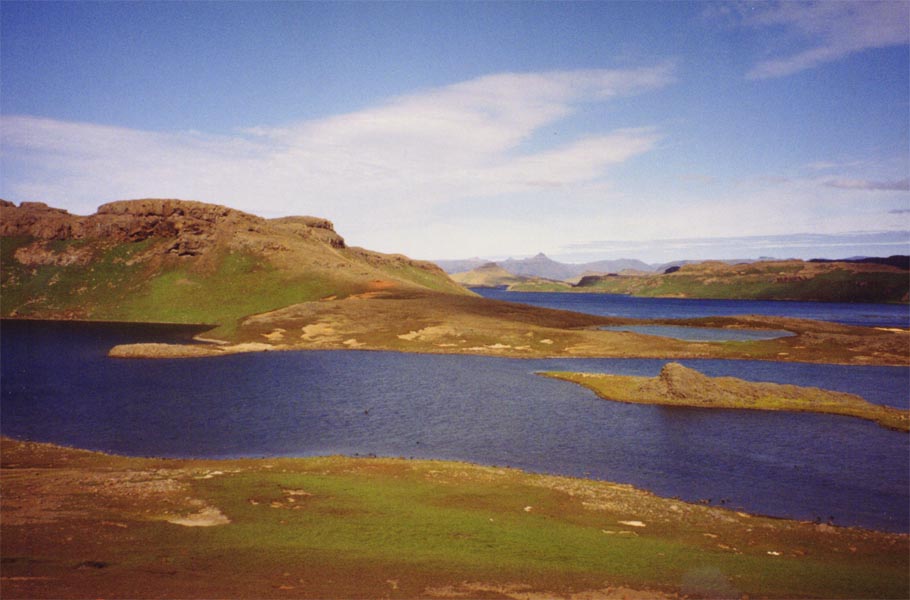
Observatory Bay
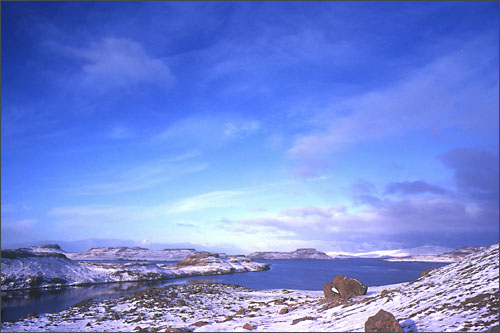
Observatory Bay in winter
|
I used the first of these nice days, on which only a weak wind blew, to take a panoramic photograph from the
so-called "Stair", the already mentioned highest mountain in the surroundings.
But such days, on which the magnificent scenery of the island unfolds to the observer, remained utmost rare.
Because the whole year through the weather retains its rough, uncomfortable character. Most frequent are the
rain- and snow-rich gusts that come up form west and northwest, which succeed each other with only short
interruptions.
Our station was well sheltered against this continuous chain of stroms because, as I already mentioned, the station
house was built close to the east flank of the so called Station Mountain. So much the worse were for us the,
though seldom, therfore much stronger hurricane-like storms breaking in from East and Northeast. Still
- besides some smaller damages - the dwelling house as well as the observation houses stood the test.
It may be explainable that on such an island that is beleaguered by continuous storms the whole fauna and
flora must evolve in a peculiar way and that despite the low latitude, which, as is well-known, is on average only
49°, already forms a clear transition to the Arctic.
Trees and shrubs are completely abscent. In contrast, the land is rich in herbs, mosses and lichens. Over
20 phanerogams occur, among which the already
mentioned acanea, ocurring at the coast, and in the rock
crevasses azorellas growing in form of cushions, are the most common. Special mentioning deserves the
Kerguelen cabbage, discovered by Rofs and
ocurring only on this island, which is of great value as the only fresh vegetal food. Unfortunately, I found this
only very rarely in our region as the rabbits that were set free by the Volage expedition had reproduced enormously
and had vastly cleaned the cabbage, so that it could be found only on the hard-to-reach spots on the coast cliffs.
The heavy expansion of acaena right in the surrounsings also has to be attributed to the rabbits, who carry with
them the burdocks that easily adhere to their fur.
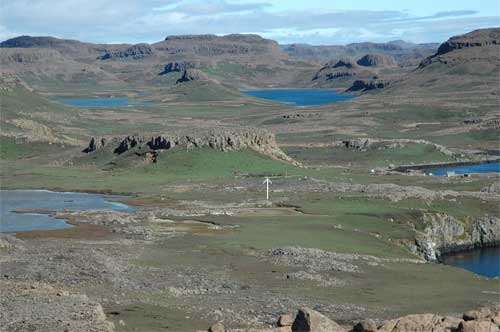
Station's location
|
As peculiar as the vegetation is also the fauna of the island. It is known that all fly and butterfly species
occrring there do in part have no wings, in part only rudimentary ones. The only flying insect is a small midge
measuring about 1 to 2 mm which can even be observed forming swarms during the rare windless intervals.
|
Penguins and seals, which according to earlier accounts occur in great numbers in the North and Northeast of the
island, were invisible in our region during the first time. Only in the course of the following year did isolated
specimens settle in the nearby coves. About 12 penguins were captured and the attempt undertaken to get them
used to captivity in order to later transport them alive to Europe. Among them were specimens of all three indigenous
species of the Kerguelens, the king penguin, the
crested penguin and the
gentoo penguin.
The number of the occurring sea birds is very large. Among them one should emphasize the
skuas and the
great black-backed gulls, the
cormorant, the delicate and swift
tern and the
southern giant petrel, also the
several species of night-diving loons.
The only land bird of great interest is the white
sheathbill Chinois.
As to the seals we could only kill four specimens, whose meat was most welcome as fresh fare besides the frequently
savoured rabbit meat. Tongue, liver and muscle meat were very tasty and each represented our daily menu for eight
days.
|
Soon after that excursion in April, the beginning of winter made itself palpable. However, it didn't bring with it
too much cold during its whole duration, as the shortfall of extremes is normal in this wholly maritime environment.
While the absolute maximum during the summer climbed exceptionally up to +18°, the observed minimum also was
in one single case -8°. The temperature is mostly some degrees above zero and oscillates only with small amplitude.
Night frosts and snow gusts are also not seldom during summertime. The warmest period was during March.
|
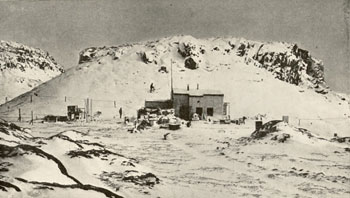
The station im wintertime
|
Wintertime consisted, similiarly as with us, in the sequence of single cold periods in which it snowed more abundantly
and the snow sometimes also remained some time. The depth of the snow cover was mostly marginal, an accurate measurement was
hardly possible because the snow was blown away by the boisterous winds and piled up at other sites, often meter-high.
We had one such cold period of longer duration at the end of July. It lasted several weeks in which the snow
partially endured. During this time we were able to state the only case of ice floes drifting in Observatory Bay,
which had formed in some exceptionally calm nights in the wind-sheltered coves.
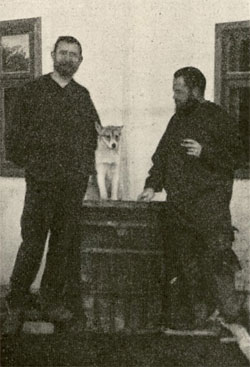
Emil Werth and Josef Enzensperger
at the station.
Photographed by Karl Luyken
|
About this time it happened that the state of health of colleague Werth raised stern concerns. Already after
his excursion in April he had complained about insomnia, faintness and fast-arriving exhaustion. To our
great apprehension, at the beginning of August, watery swellings appeared at his lower limbs and forced him to
complete dormancy. When the water swellings started moving upwards he could no longer leave bed. In addition,
acute pain of the lungs occurred which caused respiratory anxiety. After several frightful days during which we
already had prepared for the worst, however, his condition ameliorated. The water slowly receded and during the
last days of August he was again able to spend some time out of bed. During the whole following time however,
Mr. Dr. Werth, was not able to attain full health, even if sometimes a delectable step towards it
appeared. During his work, utmost caution was necessary, as the slightest effort caused again swellings. Towards
the end of our time, once again he relapsed owing to an emotion caused by a sad cause and impetuous effort,
which he is still suffering after his transfer to Sydney.
|
When Dr. Werth had superated his first bout, Mr. Enzensperger also began to ail in September without any
specific symptoms. Only at the end of November, swellings also appeared with him at the lower limbs. Then my
suspicion, which I already had metioned at Werth's illness, became a sad conviction that we were handling the
uncanny beriberi ailment, which we seemingly had been contagiated with at that time by the diseased Chinese crew.
It was an odd tragical destiny that the infectious germs of a tropical disease had to be carried into the
antarctical clean air of the island territory, which wouldn't even let a harmless cold emerge.
This affliction was the more terrible to us as the only medicine against the hereby induced hearth affection,
digitalis, was not available, which, as is well known,
can only be prescribed by a physician. So we saw our
unfortunate companion suffer more and more, without being able to procure him appreciable relief but for small
assistance. Unfortunately, at the beginning he wouldn't want to hear our suggestions to at least render his work,
even overviewing the meteorological service with tirelss, heart-warming zealousness, in fact as long as until his
fortitude was consumed so much, that he could no longer leave bed.
From this day on, December 15th, also his hardest suffering time began. Sleep,
which up to now had provided him with a temporary strengthening during night, ceased completely as he was not able
to lay for a longer period on the same position without pain. The watery swellings grew ever more. By mid-January
his condition already was such that all hope vanished from us, as the water invaded tongue and fingertips.
On February 1st, the signs of the beginning disintegration showed up. He
also began to phantasize more and more. When he woke up from such phantasies on the evening of
February 2nd, from which we clearly heard that his soul lingered at home
with his parents and siblings, he clearly spoke out that he felt his end was nearing. Shortly thereafter,
when we all were engaged with him in order to sit him upright, as was his wish, he suddenly dwindled forth with a
deep breath. No reaction followed the immediately applied means to artificially stimulate the heart function.
He had passed away without fighting.
Two days thereafter, at 5 pm, our sailors ported the simple coffin, enveloped in a black cloth and with the
Reich's flag for service and decorated with a fresh acaena wreath to the last resting place. At the open pit,
Dr. Werth dedicated warm remembrance words for the deceased.
The perpetuated one had ever been a good and helpful friend and companion to us. As his bold self-will was on the
high mountains of the Alps - where, as is well-known, he was the first meteorologist for a whole year
at the Zugspitze - never resigning in helping the
hikers surprised and strayed by snow storms, so he also felicitously proved his sense of duty during the exertion
of his scientifical profession until the failure of his strength. On top of that he was distincted by a refreshing humor
and also an imperturbable stoicism which showed up even in hard situations. As his name will ever be mentioned
with honour in the scientifical world, so will we, his comrades, retain his memory faithfully forever!
Our circle was so affected by the suffering and pasing away from our comrade that during the following time we
remained under the impression of this painful incident. These excitements also had led once more to a dangerous
relapse with Dr. Werth. Although swellings of the limbs did not occur, heart convulsions increased from
day to day and could only be relieved by continuous cooling with well-water-filled ice packs.
As up to now with this ailment, we again felt the need of the lightest fare, which was provided for partly by our
supplies, partly by fresh meat from the ducks and rabbits. The former ones were captured either with help of
the the musket or by my faithfull hound in great amount.
We expected the arrival of the steamer that should pick us up by the beginning of March, but not until
the morning of March 30th, after four further weeks spent in anxious concern,
during which Dr.Werth's condition greatly deteriorated, did we at last hear the steam whistle of a ship, and
soon thereafter the steamer "Staßfurt" of the German-Australian Company entered Observatory Bay and anchored close
in front of the station. With it, a hard and dreary time for us came to an end.
The transfer of the station on board was soon accomplished and after only two days we could leave the Kerguelens
in order to approach the port of Sydney after a 14-day journey. There Dr. Werth, who had withstood the
crossing relatively good considering his weakened state, was admitted at once to the sanatorium of an established
physician, where, as we confidently can hope, a soon convalescence awaits him.
|
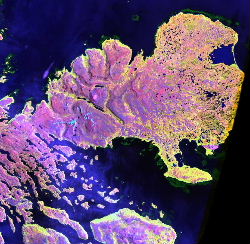
Satellite picture
Photographed on 22.5.2001
|
In order to say a word about the scientific achievements of the Kerguelen station, it is certain that they had to
suffer from the sad health condition in some ways.
It was possible to conduct the date observations of meteorology and earth magnetism prescribed by the program of the
international cooperation in full extent. Also, the biological collection could be extendend to all species of
flora and fauna occurring there.
On the other hand, the investigations aimed at the exploration of the island in the broader surroundings of the station,
as well as other important works which should supplement the program had to be omited.
Thanks to the geodetical and photographical captions in the surroundings of the station, cartography could be
completed.
|
